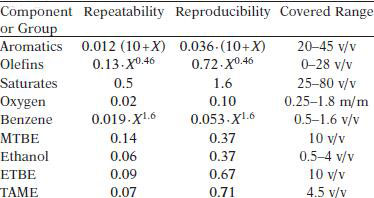EXPLANATION
A knowledge of spark ignition engine fuel composition is needed for regulatory compliance, process control, and quality assurance. A quantitative determination of olefins and other hydrocarbon types in such fuels is required to comply with government regulations. This test method is not applicable to M85 and E85 fuels which contain 85 % of methanol and ethanol, respectively. This test method quantitatively determines saturates, olefins, aromatics, and oxygenates in spark ignition engine fuels by multidimensional gas chromatography. Each hydrocarbon type can be reported either by carbon number or as a total. The method is applicable to fuels with total aromatic content up to 50 %, total olefinic content up to 30 %, and oxygen compounds up to 15 %, all v/v. This method is not intended to determine individual hydrocarbon components except benzene.
TEST SUMMARY
A representative sample is introduced into a computer controlled gas chromatographic (GC) system consisting of switching valves, columns, and an olefin hydrogenation catalyst, all operating at various temperatures. The valves are actuated at predetermined times to direct portions of the sample to appropriate columns and traps. As the analysis proceeds, the columns separate these sample portions sequentially into groups of different hydrocarbon types that elute to a flame ionization detector. The mass concentration of each detected compound or hydrocarbon group is determined by application of response factors to the areas of detected peaks followed by normalization to 100 %. The liquid volume concentration of each detected compound or hydrocarbon group is determined by application of density factors to the calculated mass concentration of the detected peaks followed by normalization to 100 %.
INTERFERENCES - Oxygenates as specified in Test Method ASTM D4815 do not interfere with hydrocarbons. Some types of sulfur containing compounds are irreversibly adsorbed in the olefin trap reducing its capacity to retain olefins. Sulfur containing compounds are also adsorbed in the alcohol and ether-alcohol-aromatic trap. However, a variety of spark ignition engine fuels have been analyzed without significant performance deterioration of these traps. Commercial dyes used to distinguish between grades and types of these fuels have been found not to interfere with the test method.
TEST PRECISION
Since no suitable reference standards are available for this analysis, no statement regarding the bias of this method can be made.

This table is Table 1 in Test Method ASTM D6839-02.
NOTE - The reporting unit for the covered range is in liquid volume percent except for the level of oxygen, which is in weight percent.



